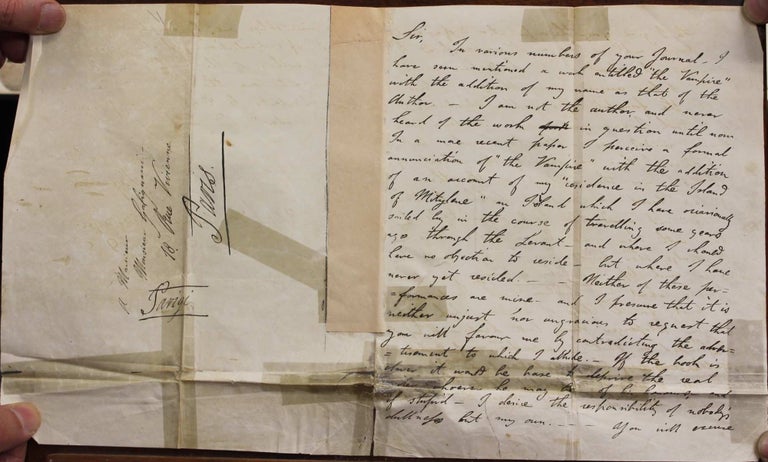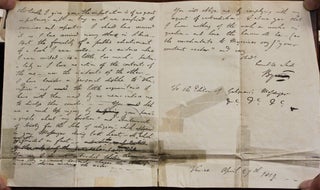A fine facsimile of a personal letter from Lord Byron to Giovanni Antonio Galignani explaining to Galignani that he is not the author of a book entitled ‘The Vampire’ that was reviewed in Galignani’s monthly publication.
c.1820. Notes: "A message received from a kind woman in New Zealand whose husband had purchased for her an 1831 edition of The Complete Poetical Works of Byron told of an insertion within, namely an original letter by Byron to the publisher Galignani that was said to have been authenticated by the British Museum. The photocopied letter is identical to one I have in my own collection. The letter is particularly intriguing because it includes Byron's denial that he wrote a work entitled The Vampyre, and he then goes on to add: 'I have besides a personal dislike to Vampires and the little acquaintance I have with them would by no means induce me to divulge their secrets.' The handwriting is certainly Byron's.
.
"How could there be two original copies of this letter? Who actually owned the original copy of this letter? I found myself on the trail of vampires and repeatedly bumping up against quirky historical personalities striving to use misrepresentation to advance their own ends.
.
"I quickly learned that Byron's 'vampire' letter had been published in the standard collections of Byron's letters by Coleridge and subsequently Marchand with whom I corresponded in the last century. Furthermore, Marchand's notes gave his source as a facsimile in Galignani's edition of Byron's Works. It would appear that these 'autograph letters' had actually been duplicated en masse by the semi-scrupulous Galignani, a man who made his living by putting out continental editions of the British poets without paying a penny for the copyrights. But how could a printer in the 1820s create a facsimile so convincing that it still allows unscrupulous booksellers to pass this letter off as an original? I have subsequently been consulted by many more individuals owning copies of the same letter, which they often believe to be an original in Byron's own hand. One professional artist declared herself absolutely certain that she possessed 'a real letter and not a copy.' Another copy belongs to a man in Denmark who has received assurances from the Danish National Museum that the paper dates from the early nineteenth century and the handwriting is Byron's. I have also heard from a professor in the United Kingdom who thought that perhaps the Galignani facsimiles were copies of an 'early draft' since the letter he had examined in Britain was so convincingly original.
.
"It turns out that this letter has a certain amount of fame (or even infamy) in collecting circles. The Encyclopedia Britannica seems to mention it obliquely in its entry on 'forgery' when the editors point out that 'some early editions of Byron's work ... contained a facsimile of an autograph letter of the poet,' adding that 'if such facsimiles are detached from the volumes that they were intended to illustrate, they may deceive the unwary.' Charles Hamilton in his book on Collecting Autographs and Manuscripts warns his readers specifically about this letter along with a handful of others.
.
"I have subsequently inspected three copies of it held in the Pforzheimer collection of the New York Public Library. They are indeed impressive. Each is folded up as if ready to be mailed, with the address inscribed on the back of the outer sheet. Nowhere within the table of contents or the preliminary 'Advertisement' in the books themselves is there any indication that a facsimile is included. This omission is all the more notable since the publisher sometimes devotes hundreds of words to brightly blazoning all the minute advantages of his edition. Perhaps Monsieur Galignani would not be too concerned or too surprised if an occasional rural bookseller passed the volume off as containing Byron's original letter ― just the right touch of stature for some wealthy patron's private collection. At the same time, he did mention the facsimile in the general catalogue of his firm included rather obscurely at the end of the 1829 printing of The Poetical Works of Thomas Moore. Discovering that the letter is a facsimile cracked open the door of history and began to whet my appetite for more biographical knowledge.
.
"Why was The Vampyre originally attributed to Byron? Why did that tale continue to be accepted as Byron's long after his denial? And how was such a convincing facsimile made so early? The genesis of The Vampyre is itself imbued with mystery and deception. The work was written by John Polidori, a bumptious young physician with literary pretensions who had accompanied Byron during the first few months of his exodus from England following Byron's scandalous separation from his wife Anabelle in the spring of 1816. Polidori had been the youngest man ever to graduate with a medical degree from the University of Edinburgh and could be irritatingly vain. He once asked what, besides scribble verses, Byron could do better than Polidori himself. To this Byron icily replied: 'Three things. First, I can hit with a pistol the keyhole of that door. Secondly, I can swim across that river to yonder point. And thirdly, I can give you a damned good thrashing.' -SATURDAY, 21 FEBRUARY 2009
Lord Byron, Polidori and The Vampyre (http://vampireresearchsociety.blogspot.ca/2009/02/lord-byron-polidori-and-vampyre.html). Item #B4166
Notes: "A message received from a kind woman in New Zealand whose husband had purchased for her an 1831 edition of The Complete Poetical Works of Byron told of an insertion within, namely an original letter by Byron to the publisher Galignani that was said to have been authenticated by the British Museum. The photocopied letter is identical to one I have in my own collection. The letter is particularly intriguing because it includes Byron's denial that he wrote a work entitled The Vampyre, and he then goes on to add: 'I have besides a personal dislike to Vampires and the little acquaintance I have with them would by no means induce me to divulge their secrets.' The handwriting is certainly Byron's.
.
"How could there be two original copies of this letter? Who actually owned the original copy of this letter? I found myself on the trail of vampires and repeatedly bumping up against quirky historical personalities striving to use misrepresentation to advance their own ends.
.
"I quickly learned that Byron's 'vampire' letter had been published in the standard collections of Byron's letters by Coleridge and subsequently Marchand with whom I corresponded in the last century. Furthermore, Marchand's notes gave his source as a facsimile in Galignani's edition of Byron's Works. It would appear that these 'autograph letters' had actually been duplicated en masse by the semi-scrupulous Galignani, a man who made his living by putting out continental editions of the British poets without paying a penny for the copyrights. But how could a printer in the 1820s create a facsimile so convincing that it still allows unscrupulous booksellers to pass this letter off as an original? I have subsequently been consulted by many more individuals owning copies of the same letter, which they often believe to be an original in Byron's own hand. One professional artist declared herself absolutely certain that she possessed 'a real letter and not a copy.' Another copy belongs to a man in Denmark who has received assurances from the Danish National Museum that the paper dates from the early nineteenth century and the handwriting is Byron's. I have also heard from a professor in the United Kingdom who thought that perhaps the Galignani facsimiles were copies of an 'early draft' since the letter he had examined in Britain was so convincingly original.
.
"It turns out that this letter has a certain amount of fame (or even infamy) in collecting circles. The Encyclopedia Britannica seems to mention it obliquely in its entry on 'forgery' when the editors point out that 'some early editions of Byron's work ... contained a facsimile of an autograph letter of the poet,' adding that 'if such facsimiles are detached from the volumes that they were intended to illustrate, they may deceive the unwary.' Charles Hamilton in his book on Collecting Autographs and Manuscripts warns his readers specifically about this letter along with a handful of others.
.
"I have subsequently inspected three copies of it held in the Pforzheimer collection of the New York Public Library. They are indeed impressive. Each is folded up as if ready to be mailed, with the address inscribed on the back of the outer sheet. Nowhere within the table of contents or the preliminary 'Advertisement' in the books themselves is there any indication that a facsimile is included. This omission is all the more notable since the publisher sometimes devotes hundreds of words to brightly blazoning all the minute advantages of his edition. Perhaps Monsieur Galignani would not be too concerned or too surprised if an occasional rural bookseller passed the volume off as containing Byron's original letter ― just the right touch of stature for some wealthy patron's private collection. At the same time, he did mention the facsimile in the general catalogue of his firm included rather obscurely at the end of the 1829 printing of The Poetical Works of Thomas Moore. Discovering that the letter is a facsimile cracked open the door of history and began to whet my appetite for more biographical knowledge.
.
"Why was The Vampyre originally attributed to Byron? Why did that tale continue to be accepted as Byron's long after his denial? And how was such a convincing facsimile made so early? The genesis of The Vampyre is itself imbued with mystery and deception. The work was written by John Polidori, a bumptious young physician with literary pretensions who had accompanied Byron during the first few months of his exodus from England following Byron's scandalous separation from his wife Anabelle in the spring of 1816. Polidori had been the youngest man ever to graduate with a medical degree from the University of Edinburgh and could be irritatingly vain. He once asked what, besides scribble verses, Byron could do better than Polidori himself. To this Byron icily replied: 'Three things. First, I can hit with a pistol the keyhole of that door. Secondly, I can swim across that river to yonder point. And thirdly, I can give you a damned good thrashing.' -SATURDAY, 21 FEBRUARY 2009
Lord Byron, Polidori and The Vampyre (http://vampireresearchsociety.blogspot.ca/2009/02/lord-byron-polidori-and-vampyre.html).
Price: $375.00


